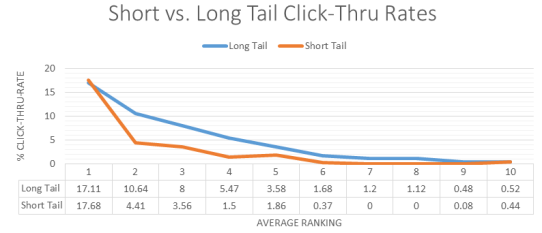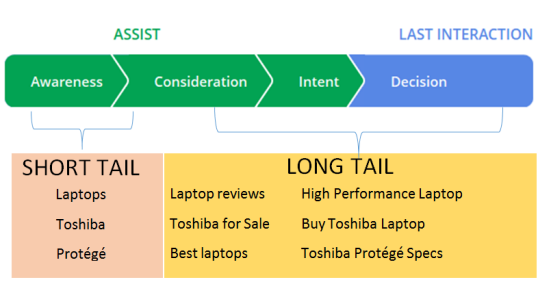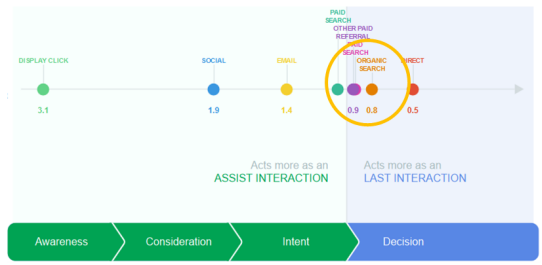Search Intent: Short vs. Long Tail Keyphrases
February 11, 2014Often times search marketers get caught up chasing after the highest traffic keyphrase, clawing and scratching their ways to the top of the bountiful SERPs, only to find a <1% CTR and no conversions. Yes, your title and description may not be engaging enough, yes, you could A&B test until your fingers bleed from writing metadata; but no, you will not increase CTR unless you can maintain an average position of 3 or higher, or trigger an enhanced listing.
Catalyst recently released a study on Click Through Rates, more closely analyzing how search intent impacts CTR. I found the data interesting and supportive of the purchase funnel we all hold near and dear to our digital hearts. The study validates that there is a clear difference in search intent based on the length of the search query.
Short Tail Phrases
Short tail keyphrases are typically one word, the generic name of a product or brand, and have higher traffic volumes than long tail keyphrases.
| Phrase | Search Volume |
| Toshiba | 165,000 |
| Laptops | 201,000 |
| Protégé | 27,000 |
Search Intent
A searcher’s intent when using short tail keyphrases is more exploratory and indicates they are at the beginning of their customer journey or decision making process. Consider it “window shopping” on search engines. The searcher is either gaining awareness or expressing consideration but not acting, hence the lower click-thru rates associated with short tail keyphrases. These searchers aren’t even ready to exercise their index finger and click on a search engine result lower than the first few positions.
Click-Thru Rates
- 13.27% decrease in CTR from 1st to 2nd position, whereas long tail keyphrases only saw a 6.47% decrease in CTR
- 0% CTR for short tail keyphrases in 7th and 8th position
- Given the nature that short tail phrases tend to be branded terms or generic names for products or services, it can be expected that there is a substantially higher decrease in CTRs from the 1st to 2nd position.
Long Tail Phrases
Long tail keyphrases consist of multiple words; these queries are more specific search queries and tend to have lower search volumes than short tail keyphrases.
| Phrase | Search Volume |
| Laptop Reviews | 49,500 |
| Best Laptops | 49,500 |
| Toshiba for Sale | 2,400 |
| High Performance Laptop | 260 |
| Buy Toshiba Laptop | 140 |
| Toshiba Protege Specs | 10 |
Search Intent
A searcher’s intent using long tail keyphrases is more specific, typically suggesting the searcher is further along in their decision making process or already has a good idea of what they are looking for. These searchers are either ready to make a decision, need an answer to a specific question, or are looking to purchase.
Click-Thru Rates
- 19.9% higher CTRs than short tail keyphrases
- 6.47% decrease in CTR from 1st to 2nd position
- Long tail keyphrases have a more consistent decrease in CTR based on position than for short tail keyphrases.
Search Intent and the Customer Journey
Short and long tail keyphrases can be good indicators of where a visitor is in the customer journey or purchase funnel. Knowing the intent of a short tail keyphrase search is more exploratory, it makes sense that the click-thru rates are lower. As for long tail keyphrases, which are more action-oriented, it makes even more sense that the click-thru rates are higher.
Where does SEO sit in the path to purchase?
According to Google, SEO has been classified as a digital marketing channel that acts more as a last interaction in the customer journey or purchasing funnel. Google has a goal of being an “answer engine” instead of a search engine. With that said, longer search queries typically provide better results or an “answer” to a searcher’s query. Some search marketers, myself included, would assume a good search strategy is to target a healthy amount of long tail keyphrases. These phrases drive action and more qualified traffic, target people ready to make a purchasing decision, have a higher ROI, and tend to be easier to rank for because of the lower competition.
Applying the Knowledge
Understanding the average click-thru rates for short vs. long tail keyphrases is great, but how should this knowledge be applied to your SEO and overall digital marketing strategy?
- If you want to increase more traffic to your site, a long tail strategy should yield a higher ratio of search traffic / search volume.
- E-Commerce websites must have a long tail strategy to target more qualified traffic ready to purchase.
- The length of a search query is directly related to a searcher’s intent.
- Is that single word high traffic keyphrase worth all the fuss? Unless you can maintain an average position of 3 or higher, it’s probably not as valuable for you to target in your SEO campaign as you would think based on search volume alone.
With Google now hiding keyword-level search data, being able to measure which keywords are driving traffic is much more difficult so understanding industry trends like CTR is more important than ever in the SEO community. If organic search serves as more of a last interaction touch point and we know that long tail keyphrases drive the most action, we can assume targeting relevant long tail keyphrases in our campaigns is worthwhile, despite the lower search volumes.
If you haven’t seen the new Click Through Rate Study by Catalyst, you can download it here for free.
Have you noticed the click through rates of the keyphrases in your SEO campaign vary based on the length of the keyphrase / search intent behind those keyphrases? Share your stories in the comments below.








